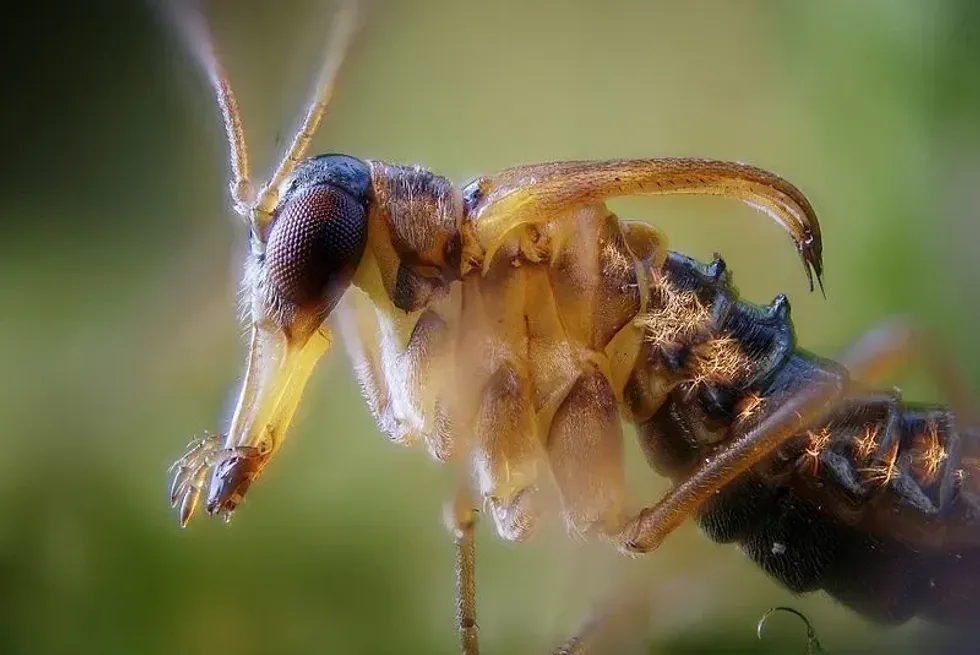While many associate the winter months with an insect-free time, that may not be the case for all the insects. Snow fleas are among those insects.
These little wingless creatures can live through extremely low temperatures. It was stated in a study published by the Biophysical Journal that they have glycine-rich antifreeze protein in their body, which helps them to deal with the extreme temperature drop.
Not only is this protein helpful to them, but it is also helpful to human beings in an indirect way. Snow fleas, also known as springtails, prevent the ice crystals from growing larger.
Many confuse these little insects with bugs, but they are not really bugs. They fall under the hexapod category, which is a subtype of the arthropods.
Snow flea (Hypogastrura nivicola) is a dark blue springtail species. Well, as you may have already guessed from the name, these creatures use their ability to jump and to move from one place to another. However, unlike other fleas, they do not have long legs.
Instead, they use their springlike tail to jump from one place to another. Not only that, but they are also quite fast. They can move at a speed of 1.4 m/s.
Snow fleas do not show any characteristics of a parasite, and they are neither harmful to you or your pets. Snow fleas do not bite either.
However, it is only natural to not want to have snow fleas in your house. Interestingly, snow fleas in house conditions are found only in winters. Be it your pet or yourself, to get rid of these critters, you need to wash using a mild soap.
Keep on reading to learn more interesting facts about snow fleas.
Are you interested to learn about such interesting insects? Then don't forget to read about leaf-footed bugs and stink bugs.
Snow Flea Interesting Facts
What type of animal are snow fleas?
Snow fleas, also known as springtails, are hexapods. Hexapod is a subtype belonging to the arthropod family. Although at first glance, it is all the more natural to link these wingless creatures to bugs, in reality, they do not fall into that category. The reason behind this common confusion is that they look very similar to bugs.
What class of animal do snow fleas belong to?
Snow fleas belong to the hexapod class, which is a subtype of arthropods.
Here is some interesting fact about the hexapod subtype - the hexapod subphylum takes into consideration insects alongside arthropods. Three groups of arthropods that are small and wingless also comes under this subtype.
How many snow fleas are there in the world?
The exact number of snow fleas in the world is unknown. However, there are 2000 different species of snow fleas all across the world. Among which 350 species can be found in North America itself. Apart from that, a huge majority of snow fleas can be found in the Nearctic zone, North America, Greenland, and Ontario.
Where do snow fleas live?
Snow fleas, just as the name suggests, can be found on the surface of the snow. However, that's not all. They can also be found on decaying organic matters such as leaf litter, rotten logs, and even in wooded areas. Even during the warmer part of the winter months, these insects can be found living on melting snow.
What is a snow flea's habitat?
Although their name suggests that the snow fleas should be found in areas covered with snow, that's not always the case in reality. Snow fleas are found all across the world living on melting snow or organic matter, most of which is decaying.
However, the majority of these insects are found in the Nearctic zone of North America, Greenland, and Ontario.
Who do snow fleas live with?
Snow fleas live in large groups, similar to other fleas.
How long do snow fleas live?
It has not yet been discovered that for how long they live. However, it is easier to spot snow fleas in winter, or even in winter lands, such as the Nearctic zone, than to spot snow fleas in summer.
How do they reproduce?
In an interesting turn of creation, the winter-loving snow fleas mate during the springtime. It helps the female because they lay eggs in the soil. The females lay around 400 eggs at a time. The young snow fleas that emerge after the hatching looks the same as an adult, albeit they are much smaller.
What is their conservation status?
The conservation status of the snow fleas or springtails has not yet been listed in accordance with the International Union for Conservation of Nature or the IUCN Red List.
Snow Flea Fun Facts
What do snow fleas look like?

The black-colored critters are extremely small in size. They are around 0.04-0.4 in (1-10 mm) long, with an elongated oval-shaped body and antennae sticking out of their head. They have a springtail attached under their abdomen, called a furcula.
Instead of using legs, the insects use the furcula to jump around the snow. The furcula is attached to the abdomen by the retinaculum, which is a clasp-like structure. The retinaculum helps the critters to jump and move forward.
How cute are they?
The insects cannot really be classified as cute as they do not look appealing. They look more like black blotches on white snow. Also, given their nature of making a home on rotten organic matter, we can no way attribute them to a high score on the cuteness quotient.
How do they communicate?
It is not yet known how the springtail communicates.
How big are snow fleas?
Springtails are considerably small in size. Their length is around 0.04-0.08 in (0.1-0.2 cm), which is almost six times smaller than an ant.
How fast can snow fleas move?
Snow fleas in snow can move at a speed of 1.4 m/s. Snow fleas use their springtails to move from one place to another, alongside their legs.
The springtails remain attached to their abdomen with the help of a clasp-like structure named the retinaculum. The springtail - which also gives them their name - is often called a furcula. Using the furcula, they jump and move forward.
How much do snow fleas weigh?
As you may already have guessed, their weight is almost negligible. However, their exact weight has not yet been discovered.
What are their male and female names of the species?
There are no specific names for the male and female counterparts of snow fleas. Thus, both the male and female snow fleas are called snow fleas.
What would you call a baby snow flea?
The baby snow fleas do not have any particular name. They go by the name of the parent species, which in this case is the fleas. Baby snow fleas are thus called flea larvae.
What do they eat?
Snow fleas are among the very few insect species that can live through the freezing temperature. They are believed to feed upon bacteria, alongside algae and fungal spores living on decaying organic matter, since the insect is an omnivore.
Are they dangerous?
Although the insect looks really gross, they are not really harmful. They do not bite, thus do not possess any harm to humans. However, if you are a pet lover, then there is bad news for you.
Snow fleas and pets do not make a great combination, and it can be quite difficult to get rid of the snow fleas on dogs. However, they won't bite your dog. It is mostly because of the soil in your dog's fur that attracts these small creatures.
However, these insects are also considered useful to human beings. According to Biophysical Journal, they have a type of protein in their body named glycine-rich antifreeze protein, which helps them to prevent the ice crystals from growing larger.
Would they make a good pet?
Under no circumstances would the snow fleas make a pet, let alone a good pet. It can be very difficult to take care of them. Also, given that they are insects, you cannot really train or control them. Thus to have these hexapods as pets is not quite the best idea.
Did you know...
Here is one of those interesting snow fleas facts for you. Animals belonging to the avian species feed on snow fleas. They are consumed by mostly small birds. So if you ever spot a bird pecking and eating snow, know that they are in search of these wingless creatures.
Can snow fleas fly?
Snow fleas are wingless creatures, which makes them completely unable to fly. These insects use crawling and jumping as their primary method of traveling from one place to another. However, unlike other fleas, they do not have long legs.
They have small back legs that they use to crawl and a spring-like tail attached to their abdomen. They use the tail to jump and move forward. Their unique springlike tails also give them their name - springtail.
However, it would be completely wrong to underestimate their ability to move in view of their small legs. These insects can move at a speed of 1.4 m/s and jump as high as 12 in (30.48 cm) in the air.
What do snow fleas use their legs for?
Apart from their springtail, the insects use their legs to move from one place to another.
Similar to any other insect, even the snow fleas also have six legs. However, researchers have discovered that there is more resemblance between their legs and crustaceans than that of an insect.
Here at Kidadl, we have carefully created lots of interesting family-friendly animal facts for everyone to discover! Learn more about some other arthropods including the Christmas beetle and the bombardier beetle.
You can even occupy yourself at home by drawing one of our Snow Fleas coloring pages.










